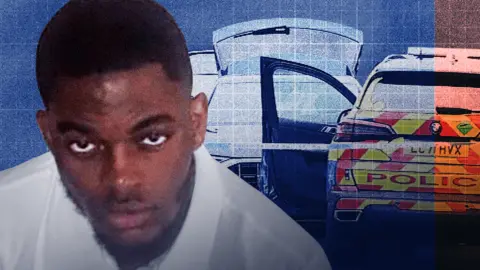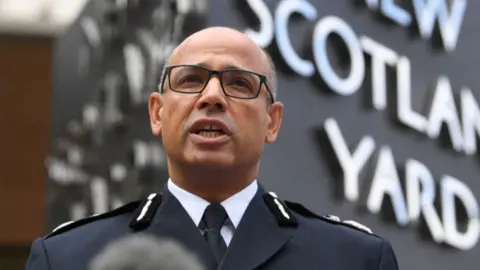Police watchdog lead defends Chris Kaba decision
 BBC
BBCThe man who led the investigation into the shooting of Chris Kaba has defended the decision that led to a firearms officer being unsuccessfully tried for murder.
Sal Naseem’s assessment that murder may have been committed has drawn fierce criticism following the acquittal of the officer. But speaking publicly for the first time about the case, he told BBC Panorama he had not been convinced that Mr Kaba presented a sufficient danger to justify being shot.
Sgt Martyn Blake, an officer in the specialist firearms unit MO19, was found not guilty of murder last month, prompting protests from the Kaba family.
The Metropolitan Police says the system for holding police officers to account must be reformed.
Panorama has spoken to a former Met Police firearms officer who believes 24-year-old Chris Kaba would have survived the police operation to carry out an armed stop on the night of 5 September 2022, were it not for the unexpected intervention of the police car containing Sgt Blake.
Mr Kaba was shot in the head after he tried to ram his way out of a police vehicle stop in south London. No firearms were recovered from the Audi he was driving.
The Audi had been linked to a reported drive-by shooting the previous day.
During his trial, Sgt Blake said it was his genuinely held belief that there was an imminent threat to life and that he had not intended to kill Mr Kaba.
Mr Naseem led the investigation for the police watchdog, the Independent Office for Police Conduct (IOPC). This is the first time he has spoken publicly about the Kaba case.
“A police officer can only use lethal force when it’s absolutely necessary,” he says. At the point the weapon was fired, Mr Naseem says that he did not think that appeared to be the case.
After the trial, the judge lifted reporting restrictions on information which had not been made known to the jury. This allowed the media to reveal Mr Kaba was part of a gang called the 67. He had a string of criminal convictions including one for possession of an imitation firearm, and another for possessing a knife.
He had been filmed by CCTV cameras shooting and wounding a rival gang member in a packed nightclub in east London six days before the police armed stop. Two members of the 67 gang were later jailed for their role in the nightclub shooting.
Mr Kaba was surrounded by armed police during the stop, demanding he get out of the car. Had he done so, he might have lived.
BBC Panorama has also been speaking to Mr Kaba’s mother and father, Helen and Prosper Kaba, since their son was killed.
Prosper Kaba said that “the role of the police is not to kill”, that their son should instead have stood trial and, if convicted, gone to prison for the criminal activity they now know he was involved in.
‘Things were on a knife edge’
Within two hours of the shooting of Mr Kaba, the IOPC was called in. Its task was to assess whether the use of lethal force was lawful or whether criminal offences may have been committed. It had the remit to send files to the Crown Prosecution Service (CPS).
By 9 September 2022, the decision had been made to open a homicide investigation.
“It was fed back to us… that if we hadn’t done it at that time then it’s likely there would have been a level of disorder,” says Mr Naseem. “Things were on a knife edge”.
Mr Kaba’s shooting had led to protests across England and Wales and accusations of police racism.
Former Met Assistant Commissioner Neil Basu, the UK’s most senior officer of colour at the time, says the decision to begin a homicide investigation seems to have been made hastily in response to outside pressure.
“To come out so early in an investigation and announce that they are looking at it as a potential murder investigation, it seems remarkable that happened so quickly,” he says.
“I worry there was some short-term thinking that said this is a way of avoiding a crisis of confidence.”
On the night Mr Kaba was shot, officers in the Met’s firearms unit – MO19 – had been following an Audi through south London because they knew it had been linked to a shooting the night before.
However, they had no intelligence about who was behind the wheel.
They planned to carry out an armed stop and force the driver out of the car.
But in the Streatham area, Mr Kaba unexpectedly turned into a side street where a marked police vehicle was waiting, with Sgt Blake and other armed officers inside. They had been expecting to join the back of the follow. However, the operational firearms commander (OFC) did not know they were there.
The driver of Sgt Blake’s vehicle pulled forward into the road to intercept the car Mr Kaba was driving, but neither this police vehicle nor the police vehicle immediately behind the Audi boxed it in tightly, so it had room for manoeuvre. Mr Kaba then attempted to reverse his way out, ramming the police vehicle behind.
Sgt Blake and a number of other officers got out of their vehicles and began shouting at Mr Kaba to do likewise. When he didn’t comply, officers tried to break open his car windows.
Mr Kaba then tried to drive forward and ram his way past the police vehicle in front, smashing into it and a white car parked on the street.
When that did not work, he reversed the car again and rammed another police vehicle.
By this point, Sgt Blake had run around to the front of the Audi and was pointing his gun at the windscreen. He fired through it and killed Mr Kaba with one shot to the head.
Sgt Blake told the police watchdog that he shot Mr Kaba because he had a genuinely held belief that one or more of his colleagues would be killed by the car.
 PA Media
PA MediaThere were 11 officers at the scene, all with body-worn cameras. Their footage later helped the IOPC piece together what happened that night.
Mr Naseem says he had a “visceral reaction” to what he saw.
“It’s a split-second decision but for [Sgt Blake] to discharge the firearm there has to be a significant threat to life. At the time he did, I just didn’t think there was cause.”
Mr Basu disagrees, and says it was dark, and the situation was chaotic. “This car is revving its engine. It’s ramming other cars and it’s a two-tonne vehicle. And firearms officers are not having the effect that firearms officers would expect, which is immediate surrender.”
The time between Sgt Blake getting out of his vehicle and making the decision to discharge his firearm was less than 20 seconds.
“I think the chaos of that situation […] we’re asking a huge amount of police officers to make different decisions to save life in those circumstances,” says Mr Basu.
‘Chris Kaba would still be alive today’
The BBC has also spoken to a former firearms officer who used to work for the same unit as Sgt Blake.
“The truth is that some things went wrong in the operation… If Blake’s vehicle had not got involved in the stop, I think Chris Kaba would still be alive today,” says the officer, who does not want to be identified but is familiar with operational tactics.
They explain that because the operational firearms commander did not know Sgt Blake and his colleagues were parked in the side street, he would also not have known that they were about to intervene.
“So, when they moved to intercept the car Chris Kaba was driving, the OFC didn’t know they’d effectively initiated the armed stop,” the officer says.
“And because of how it happened, it was a more dangerous type of stop than the one originally planned.”
“It wasn’t safe, and it put officers in danger.”
The officer says Sgt Blake was dropped into a really difficult situation.

Panorama speaks to the parents of Chris Kaba, as well as the man who led the IOPC investigation into the fatal shooting and a former Met Police firearms officer who served in the same unit as Sgt Martyn Blake.
Watch on BBC iPlayer or on BBC One on Monday 04 November at 20:00 (20:30 in Wales and Northern Ireland)
Last month, Sgt Blake stood trial for murder. The jury came back with a not-guilty verdict after deliberating for three hours and 20 minutes.
Mr Naseem has since left the IOPC. While fully accepting the jury’s verdict, he stands by the decision to refer the case to the CPS.
“If this was textbook, then why did the Crown Prosecution Service issue such a serious charge?” he says.
“That tells you that that very initial reaction I had to watching the footage… was actually borne out by another independent body.”
The CPS said in a statement it recognises “firearms officers operate under enormous pressure, but it is our responsibility to put cases before a jury that meet our test for prosecution… We are satisfied that test was met in this case”.
Reacting to the not-guilty verdict, Metropolitan Police Commissioner Sir Mark Rowley said no officer was above the law but the system holding police to account was “broken”.
He said his armed officers respond to more than 4,000 incidents a year but only one or two result in shots being fired. He added that he worried about “the lack of support officers face” and “most of all I worry for the public”.
Days later, Home Secretary Yvette Cooper announced reforms aimed at improving police accountability, one of which involves a presumption of anonymity for firearms officers charged with criminal offences after police shootings.
Sgt Blake has now had his suspension by the Met Police lifted and the IOPC is reviewing its recommendation that he should face a gross misconduct hearing.
An inquest into the death of Mr Kaba is expected next year.
In a statement to Panorama, the Met said: “The facts of this case were tried and tested in a criminal court over two weeks. A jury of 12 men and women, having heard all of the evidence found Sgt Martyn Blake not guilty of murder.
“Our focus remains on serving and protecting the communities of London and supporting the brave men and women who step forward to do so every day.”
Additional reporting by Kirstie Brewer







